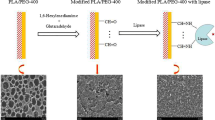Abstract
The derivatives of polyethylene glycol (PEG) were prepared by reacting PEG with propylene oxide to enhance its hydrophobicity and introduce a branched structure. The PEG derivatives were activated with cyanuric chloride and used to modify the lipase fromCandida rugosa. The maximum specific activity of lipase modified with the PEG derivatives was about 2-fold of that modified with PEG for the esterification of oleic acid and lauryl alcohol in hexane.
Similar content being viewed by others
References
Abuchowski A,Van ET,Palczuk NC,Davis FF (1977) Alteration of immunological poperties of bovine serum albumin by covalent attachment of polyethylene glycol. J. Biol. Chem. 252: 3578-3581.
Basri M,Ampon K,Wan Yunus WMZ,Razak CAN,Salleh AB (1995) Synthesis of fatty esters by polyethylene glycol-modified lipase. J. Chem. Technol. Biotechnol. 64: 10-16.
Fields R (1972) The rapid determination of amino groups with TNBS. Meth. Enzymol. 25B: 464-468.
Gorman LA,Dordick JS (1992) Organic solvents strip water off enzymes. Biotechnol. Bioeng. 39: 392-397.
Goto M,Kameyama H,Goto M,Miyata M,Nakashio F (1993) Design of surfactants suitable for surfactant-coated enzymes as catalysts in organic media. J. Chem. Eng. Japan. 26: 109-111.
Jene Q,Pearson JC,Lowe CR (1997) Surfactant modified enzymes: solubility and activity of surfactant-modified catalase in organic solvents. Enzyme Microbiol. Technol. 20: 69-74.
Kawase M,Tanaka A (1989) Effects of chemical modification of amino acid residues on the activities of lipase from Candida cylindracea. Enzyme Microbiol. Technol. 11: 44-48.
Laane C,Boeren S,Vos K,Veeger C (1986) Rules for optimization of biocatalysts in organic solvents. Biotechnol. Bioeng. 30: 81-87.
Ljunger G,Adlercreutz P,Mattiasson B (1993) Reactions catalyzed by PEG-modified α-chymotrypsin in organic solvents: influence of water content and degree of modification. Biocatalysis 7: 279-288.
Pan S,Kawamoto T,Fukui T,Sonomoto K,Tanaka A (1990) Stereoselective esterification of halogen-containing carboxylic acids by lipase in organic solvent: effects of alcohol chain length. Appl. Microbiol. Biotechnol. 34: 47-51.
Yamasaki M,Okabe M,Suzawa T,Yokoo Y (1998) New PEG2 type polyethylene glycol derivatives for protein modification. Biotechnol. Technol. 12: 751-754.
Author information
Authors and Affiliations
Corresponding author
Rights and permissions
About this article
Cite this article
Wu, J., Zhang, G. & He, Z. Enhanced activity of Candida rugosa lipase modified by polyethylene glycol derivatives. Biotechnology Letters 23, 211–214 (2001). https://doi.org/10.1023/A:1005675807353
Issue Date:
DOI: https://doi.org/10.1023/A:1005675807353



